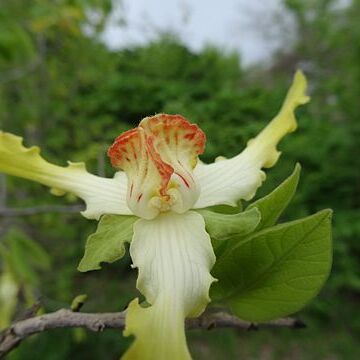Shrub or small tree (1.5–)2.5–12 m. tall, usually much branched and occasionally somewhat climbing; bark thin, pale brown or grey, smooth; young branchlets dark, at first greyish pubescent, later glabrous, lenticellate.. Leaf-blades obovate or oblong to oblanceolate, 2–20(–24) cm. long, 1.5–8.2 (–8.7) cm. wide, rounded, apiculate or shortly acuminate at the apex, cordate at the base, thin or sometimes eventually somewhat coriaceous, bluish-green, sometimes glaucous beneath, ± densely softly pubescent on both surfaces or practically glabrous save for ciliate margins; venation reticulate and prominent on both surfaces; petioles 2–3(–5) mm. long, often blackish, pubescent; shoot-buds enveloped in convex imbricate rugulose dark brown coriaceous scales, 4–7(–ll) mm. long, 4(–8) mm. wide, glabrous save for ciliate margins.. Flowers solitary, terminal or extra-axillary, appearing with or just before the young leaves, mostly on the older branches; pedicels2–5.7(–7.3) cm. long, slender, pubescent; bracteole ovate, 5–9 mm. long, 7 mm. wide, narrowed at apex, clasping at the base, glabrous above, adpressed pubescent beneath.. Sepals green or red with green veins, lanceolate or narrowly triangular, 1–2 cm. long, 3–5.5 mm. wide, acute, recurved, margins undulate, densely silky, pubescent outside, almost glabrous inside.. Petals whitish or yellowish, often streaked with green, speckled, margined or flushed with red or apricot, the inner sometimes entirely red; outer oblance-olate-spathulate, or linear, (3–)3.7–6.5 cm. long, 0.5–1.8(–2.6) cm. wide, acute or acuminate, recurved, margins undulate, densely pubescent outside, less so inside; inner rounded-sagittate, triangular or rhomboid, 0.7–0.9(–1.6) cm. long, 1.2–1.6 cm. wide, with a prominent claw 0.7–0.9(–1.3) cm. long, erect, ± connivent, pilose towards the apex, pubescent towards the base.. Stamens white, oblong-cuneiform, ± 1 mm. long.. Ovary globose or conic, ± 1 mm. long, glabrous save for stigmas.. Fruiting pedicel 6–8 cm. long; fruit green and white mottled, obovoid, round or ellipsoid, (4–)5–7.5 cm. long, (3.2–)4–4.5 cm. wide, glabrous, but finely rugose.. Seeds chestnut, ellipsoid or irregularly ellipsoid, often wedge-like in section, 1.3–2.6 cm. long, 1–1.8 cm. wide, 0.9–1.1 cm. thick.
More
Petals yellow to greenish-white, variously flushed with pink or red to dark brown, or the inner ones wholly reddish, the outer ones (3) 3.7–6.5 cm. long, 0.5–1.8 (2.6) cm. broad in the upper part, oblanceolate or spathulate to linear with a broadened base, acute to acuminate or cuspidate, recurved with undulate margins, more densely pubescent below than above, the inner ones 0.7–0.9 (1.3) x 0.7–1.2 (1.4) cm., sagittate to triangular or rhomboid, acute or acuminate, with a claw 0.7–0.9 (1.3) cm. long, erect, ± connivent, setose-pilose towards the apex, pubescent towards the base.
Leaves petiolate; lamina 7.5–20 (24) x 3.5–8.2 (8.7), obovate to oblanceolate (or oblong when young), obtuse or rounded to apiculate or shortly acuminate at the apex, cordate at the base, membranous or subcoriaceous, bluish-green and concolorous or glaucous below, ± densely and softly pubescent on both sides or almost glabrous, usually with ciliate margin, with nerves and reticulate venation ± prominent on both sides; petiole 2–3 (5) mm. long, often blackish, softly pubescent.
Flowers solitary, terminal or extra-axillary appearing with the young leaves; pedicel 2–5.7 (7.3) cm. long, slender, pubescent; bracteole ovate, attenuate, ± amplexicaul, glabrous above, appressed-pubescent below.
Fruit 5–7.5 x 4–4.5 cm., obovoid or ellipsoid, finely rugose, not ridged, mottled green and white, glabrous (? or shortly pubescent), pendulous, on an elongate pedicel 6–8 cm. long.
Sepals c. 1–2 cm. long, lanceolate or narrowly triangular, acute or attenuate, recurved with undulate margins, ± densely sericeous-pubescent below, almost glabrous above.
Branches spreading or pendulous, dark purple, buff-pubescent at first, eventually glabrous.
Shrub or small tree (1.5) 2.5–12 m. high, much-branched, sometimes subscandent.
Ovary c. 1 mm. long, globose or conic, glabrous except the stigmas.
Seeds 2–2.5 cm. long, bean-shaped, smooth, reddish-brown.
Stamens 1 mm. long, oblong-cuneiform.

